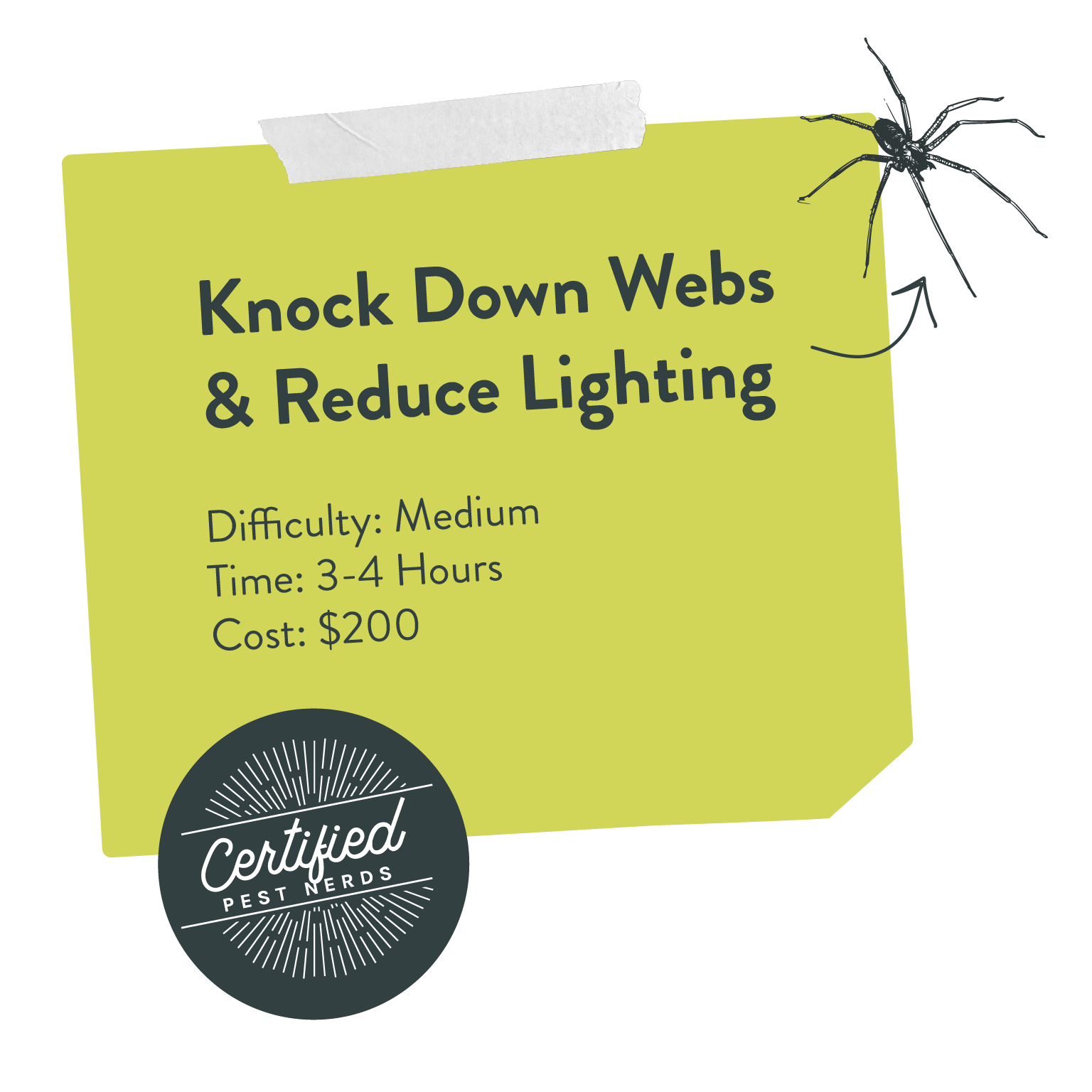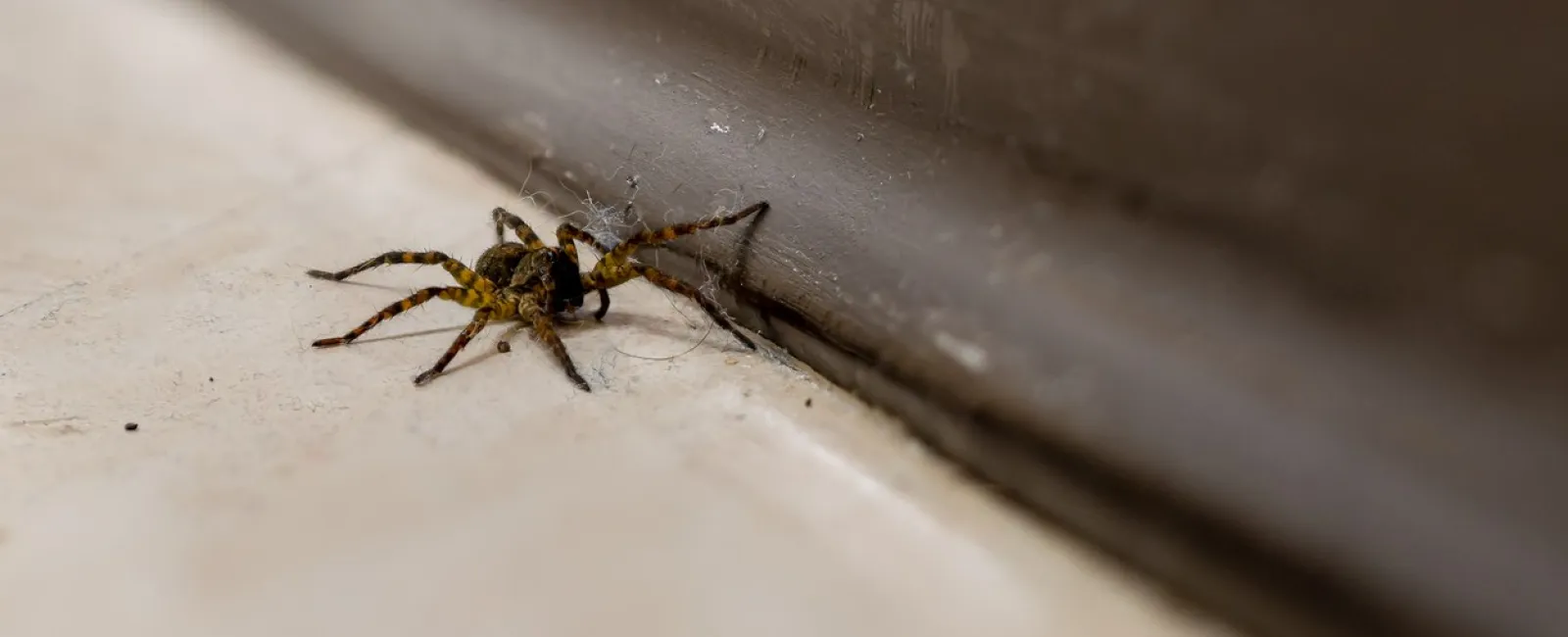We don't blame you for doing the Olympic sprint out of the room the second you spot an eight-legged intruder dangling from the ceiling. Spiders have a special talent for sending shivers down spines—and not just because their webs are the original sticky traps. They're creepy, they're crawly, and their surprise entrances are never welcome.
While spiders tend to crash the party most often in late summer and early fall, they're not exactly known for RSVPing—they can pop up year-round. Different spider species have different tastes when it comes to indoor living: some prefer quiet, shadowy corners (basement, anyone?) while others don't mind hanging out in open spaces. If you've ever found yourself asking, "Why are there spiders in my home?"—don't worry, the Pest Nerds at Greenix have answers and solutions. Identifying the exact species is key to booting them out for good, and lucky for you, that's kind of our thing.
Spiders in the House? Web-elieve It.
Spiders are some of the most common (and least welcomed) houseguests around—and they don't even ask for permission to crash on your ceiling. Found in homes across the globe, these eight-legged wonders might give you the heebie-jeebies, but they do serve a purpose: they help keep other bug populations in check.
That said, when your home starts feeling more like a haunted house than a safe haven, it's time to draw the line. Spider infestations can quickly go from annoying to concerning, especially if venomous species are involved. In this guide, we'll untangle the mystery behind spiders in your home—what draws them in, how they sneak inside, and how you (with a little help from the Pest Nerds at Greenix) can keep them from spinning their next web indoors.
The Spidey Lineup: Who's Creeping Around Your Corners?
The type of spider spinning its web in your home depends a lot on where you live—but no matter the zip code, nobody wants to get face-to-face with one just to ID it. We totally get it. Still, knowing which eight-legged guest you're dealing with can help determine if it's just an unwelcome roommate… or a full-blown red alert.
Here are a few of the usual suspects that might be lurking behind your furniture:
American House Spider
Wolf Spider
Cellar Spider (aka Daddy Long Legs)
Jumping Spider
Black Widow (yep, the real deal)
Brown Recluse (stealthy and venomous)
It's worth noting—spiders don't always just show up uninvited. Sometimes, they're following the scent of another pest buffet. In fact, other creepy crawlers (we're looking at you, mice and bugs) can attract spiders into your home. So if you've got more than one type of pest throwing a party, Greenix can help shut it down—fast.
House Spiders: Small Invaders with a Big Presence
House spiders might be tiny, but they sure know how to make their presence known—especially when they're hanging out in your bathroom corner like they pay rent. These small-to-medium-sized pests usually rock a brown or gray wardrobe (very neutral chic) and have a rounded abdomen that helps them build those pesky little webs we all know and don't love.
Spinning webs is their superpower—it's how they catch prey and dodge predators. Most house spiders are night owls, so while you're sleeping, they're busy setting up shop in quiet, dark areas like basements, closets, and corners you didn't know existed. Even worse? These resilient little creepers can survive a surprisingly long time without food or water. Translation: they're in it for the long haul if left unchecked.
Spider Behavior: What They're Up To When You're Not Looking
Spiders aren't just lurking around to give you a scare—they're natural-born predators on the hunt for their next meal (which, thankfully, isn't you). Their ideal habitat? Anywhere there's a steady buffet of bugs.
These eight-legged loners are mostly solitary and spend their time setting up shop in quiet, low-traffic areas. Think basements, attics, behind furniture, or even tangled up in overgrown plants around the house. Clutter and vegetation create the perfect hiding spots—not just for spiders, but for the insects they love to snack on.
Spiders are also a little territorial. They're not fans of roommates and will typically defend their turf from other spiders, only getting social when it's time to mate. (Ah, romance.)
Bottom line: if your home has bugs, clutter, or cozy, dark corners, you've unintentionally rolled out the welcome mat for spiders. But don't worry—Greenix knows exactly where these web-slingers like to hang out, and we're pros at clearing them (and their food source) out.
Why Spiders Come Indoors (Spoiler: It's Not for the Décor)
Whether it's a harmless little jumper doing acrobatics across your windowsill or a venomous visitor that's way too close for comfort, spiders usually have one reason for moving in: food.
Just like any pest, spiders are motivated by the Pest Trinity—food, water, and shelter. But while we're raiding the fridge for midnight snacks, spiders are stalking their favorite cuisine: other bugs. If you're seeing an uptick in spider activity, chances are their next meal is hiding somewhere nearby—and that means you've got a bigger pest party on your hands than you realized.
Homes offer spiders exactly what they need to thrive: a cozy shelter, a steady food supply (hello, flies and fruit-loving insects), and a safe place to raise their many kids. Yep—once Mama Spider settles in, she can produce hundreds (sometimes even thousands!) of baby spiders. As temperatures rise in the spring, those hatchlings may start making their debut… all over your house.
That's why year-round pest control is so important. Seasonal shifts, mating cycles, and hidden pest populations can all trigger sudden spider sightings. But with consistent, preventative pest control from the Pest Nerds at Greenix, you can shut the door on spiders—and the bugs they follow—for good.
How Spiders Sneak Into Your Home
Spiders aren't exactly knocking on the front door—but they are pretty sneaky when it comes to finding their way inside. These eight-legged invaders can slip through the tiniest cracks in your foundation, wiggle in around windows and doors, or stroll right through vents and chimneys like they own the place.
And here's the kicker—they're not above hitchhiking. Spiders often catch a ride indoors on potted plants, firewood, storage boxes, or even that delivery package you just brought in. Once inside, they waste no time exploring—and if your home has lots of cozy corners, clutter, or moisture, you might just find them setting up shop in more than one room.
The best way to keep spiders outside where they belong? Start with sealing cracks and gaps, adding weatherstripping and door sweeps, and keeping things clean and clutter-free. But if they're already in and crawling around like they pay rent, it's time to call the Pest Nerds at Greenix. We'll help you evict your eight-legged guests and block their favorite entry points for good.
How to Show Spiders the Door (Without Screaming)
Let's be real—most spiders aren't dangerous, but that doesn't mean you want them setting up camp in your living room. Whether it's one rogue web-slinger or a whole creepy crawly crew, here's how to send those eight-legged freeloaders packing.
Sweep, Vacuum, and Dust Like a Pro
Spiders love to chill in places where they won't be disturbed—think dark corners, basements, and that one closet you haven't opened since 2021. If you're finding webs, egg sacs, or spiders themselves, it's time for a deep clean.
Grab your vacuum (hose attachment is key), and give your home a once-over. Suck up webs, eggs, and any lurking arachnids you spot. For spots the vacuum can't reach, go old-school with a broom or dust rag. Once you've collected the goods? Bag it and toss it—outside.
Create a "No Spider Zone"
Looking for a natural way to tell spiders, "This is not your home"? White vinegar is your new best friend. Mix it 50/50 with water in a spray bottle and mist it around doors, windows, and other spider-prone spots. Not a fan of the smell? Peppermint or eucalyptus essential oils work wonders too—just add about 10 drops to a 16-ounce spray bottle.
These scents won't just make your home smell fresh—they'll also send spiders crawling the other way. And if DIY sprays just aren't cutting it? That's your cue to call in the pros (hi, we're Greenix). We'll get to the bottom of what's really attracting them.
Seal the Deal
Spiders are experts at slipping through the smallest openings—cracks in your foundation, gaps around doors and windows, even your vents. Do a thorough check around your home and seal up any entry points with caulk, weatherstripping, or mesh screens.
Think of it like locking all the doors to a bug-sized nightclub. If they can't get in, they can't throw a party.
Spider Control With a Greenix Service Professional
Moving into a new home should come with housewarming gifts—not unexpected spider roommates. And while DIY fixes can help with the occasional web in the corner, a full-blown spider infestation is a different story. When you're seeing spiders left and right (especially the dangerous ones), simple sprays and vinegar solutions just won't cut it.
Your peace of mind matters—but so does your safety. The best way to prevent spiders is by cutting off their food supply, which usually means evicting the other pests they're feeding on. And when it comes to spiders like the black widow or brown recluse? You don't want to roll the dice. These venomous species aren't just creepy—they can pose serious health risks.
But hey—we're not here to scare you—at least not entirely!
At Greenix Pest Control, we specialize in identifying spider species, eliminating infestations at the source, and setting up preventative barriers that keep pests (and the spiders that follow them) out for good. We handle the hard stuff so you can get back to enjoying your new space—spider-free.
Ready to reclaim your home from eight-legged invaders? Schedule your initial inspection with a Greenix Pest Control Service Professional today!

DIY Spider Prevention Steps
1. Use a broom or vacuum to remove all visible webs.
2. Pay special attention to corners, ceilings, and garages.
3. Replace bright white exterior lights with yellow bug lights.
4. Trim shrubs and plants touching your siding or windows.
5. Sweep away leaves and debris near door thresholds.

